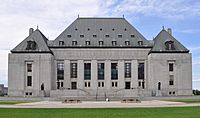Grassy Narrows First Nation v. Ontario (Natural Resources) facts for kids
Quick facts for kids Grassy Narrows First Nation v. Ontario (Natural Resources) |
|
|---|---|

|
|
| Hearing: 2014 Judgment: July 11, 2014 |
|
| Full case name | Full-case name |
| Citations | [2014] SCR 48 |
| Prior history | Judgment for the Grassy Narrows First Nation. |
| Ruling | Appeal by Ontario was denied |
| Holding | |
| Based on article 1 of an 1891 agreement, the SCC found that the "disputed territory belonged to Ontario". | |
| Court membership | |
| Reasons given | |
| Unanimous reasons by | yes |
Grassy Narrows First Nation v. Ontario (Natural Resources) was an important court case decided on July 11, 2014. It involved the Grassy Narrows First Nation and the Government of Ontario. The case was heard by the highest court in Canada, the Supreme Court of Canada.
The main issue was about who had the right to control land and resources in an area that was important to the Grassy Narrows First Nation. The court's decision allowed an appeal by Ontario. This meant that Ontario had the power to use the land, even though some felt it was unfair to the First Nation.
Contents
What the Case Was About
The Supreme Court of Canada had seven judges hear this case. They all agreed on the decision. They decided that the province of Ontario had the power, also called jurisdiction, to use land that was part of an old agreement. This agreement was called Treaty 3, signed in 1873.
This decision meant that the First Nation's rights to hunt, fish, and gather on these lands were limited. These rights are often called harvesting rights.
Why This Case Happened
In 1873, the Ojibway people, which includes the Grassy Narrows First Nation, signed Treaty 3. Through this treaty, they shared their traditional territory with Canada. The treaty said that the Ojibway would still have the right to harvest on these lands. This right would continue until the lands were "taken up." "Taken up" means used for things like new settlements, industries, or other government plans.
Later, in 1912, a part of this land, known as the Keewatin, became part of the province of Ontario.
In 1997, the Ontario government gave a company a special permit. This permit, called a forestry licence, allowed the company to cut down trees in the area. This type of tree cutting is known as clear-cutting. The company was Abitibi-Consolidated Inc., which later became Resolute Forest Products.
The Grassy Narrows First Nation did not want the logging to happen. In 2005, they went to court to try and stop it. They won their first court case. However, the Ontario Court of Appeal later changed that decision. This court said that Ontario owned the land and had the right to sell its natural resources. The Supreme Court of Canada then agreed with this ruling.
The Court's Decision
The Supreme Court looked at an old agreement from 1891. This agreement was about a historical border dispute between Canada and Ontario. Based on this old agreement, the court decided that the land in question belonged to Ontario.
The court explained that the First Nation's rights to hunt and fish on the land would not continue. This would happen if the land was "taken up" for things like settlement, mining, or lumbering by the Government of Ontario.
What Happened After
Many people felt that the court's decision was unfair to the Grassy Narrows First Nation. They felt that the First Nation had negotiated with one party, but then that party changed. This made it hard to honor the original agreement.
Some experts said that Indigenous rights should only be limited if it helps with reconciliation. Reconciliation means building a better relationship between Indigenous peoples and Canada. They felt this case did not help with reconciliation.
Even though the Supreme Court made its decision, the Grassy Narrows First Nation has continued to fight. They are determined to protect their land from further development. By 2015, they had reaffirmed their plans to continue protests and their political efforts.
See also
- R v Sparrow
- Calder v British Columbia (AG) (1971)
- Guerin v The Queen (1984)
- Delgamuukw v British Columbia (1997)
- Tsilhqot'in Nation v British Columbia (2014)

